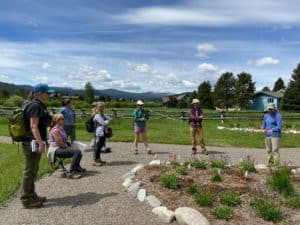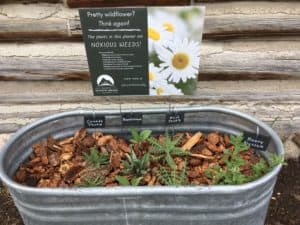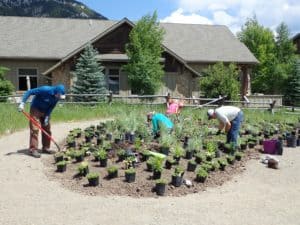Project Name: Community Outreach
Sponsoring Organization: Gallatin Invasive Species Alliance
In 2017, the caretaker of the small flower garden at Crail Ranch reached out to us, Gallatin Invasive Species Alliance, for help on weed and flower identification. Sadly, we found over half the plants were noxious weeds. We immediately recognized this as a great opportunity to honor the natural heritage of the site while showcasing sustainable land and water stewardship. The idea of creating a native demonstration garden was born.
Why are native plants important? Once established, native plants are easy to maintain because they are adapted to Montana’s temperatures, rainfall patterns, and soil conditions. But most importantly, native plants are the foundation for the food web and vital for sustaining ecosystems. Research indicates that when a landscape dips below 80% native plants, the reproduction rate of birds begins to drop. Because animals directly or indirectly depend on plants for their food, the diversity of animals in a particular habitat is very closely linked to the diversity of the plants in that habitat.
While the Alliance is well versed about the negative impacts of invasive plants, we jumped at the chance to educate the public about what comprises sustainable, healthy ecosystems – native plants!
Planning began in 2018 with the Historic Crail Ranch, Big Sky Community Organization, Gallatin River Task Force, and Big Sky Water and Sewer providing funding to hire a landscape designer and procure plant materials. In the spring of 2019, the build began with Big Sky Landscaping constructing the paths and garden beds. The Alliance, with the help of twenty-nine volunteers, planted 700 native wildflowers in four distinct garden beds. Drip line irrigation was installed to ensure newly planted flowers survived the intense summer sun, and shredded cedar mulch was added to conserve water and choke out weeds.
 With COVID hitting in early spring of 2020 and subsequent budget cuts, the Alliance lacked funding to execute our planned educational programming. Thus, we focused on ensuring garden construction and maintenance happened as planned:
With COVID hitting in early spring of 2020 and subsequent budget cuts, the Alliance lacked funding to execute our planned educational programming. Thus, we focused on ensuring garden construction and maintenance happened as planned:
-Seeded native grasses with a rock perimeter
-Installed slate flower identification signs
-Constructed a noxious weed identification planter
-17 volunteers put in 47 hours planting 115 more wildflowers and 12 new species
While most of our plans to host events at the garden had to be postponed until next year, we still welcomed Montana Outdoor Science School’s Master Naturalist group and held our inaugural Noxious Weed Bouquet Contest. The contest proved to be a huge hit with 40 people attending and 17 official entries!
The Alliance would like to extend our sincere appreciation to Resort Tax and the funding they have provided us for the past sixteen years. Not only has it had a d irect impact on our ability to address and mitigate the impacts of invasive species, but it has allowed us to “grow wild” at Crail Ranch and create a living example of sustainable stewardship for the community!
irect impact on our ability to address and mitigate the impacts of invasive species, but it has allowed us to “grow wild” at Crail Ranch and create a living example of sustainable stewardship for the community!
For more information, visit “The Gardens at Crail Ranch” page under the tab “Our Work” at www.gallatinisa.org.
“Everything that slows us down and forces patience, everything that sets us back into the slow circles of nature, is a help. Gardening is an instrument of grace.” – May Sarton
